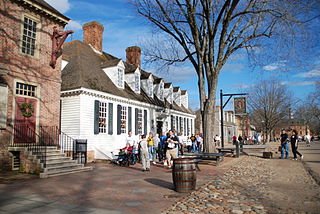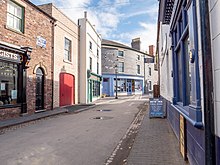
Historical reenactments is an educational or entertainment activity in which mainly amateur hobbyists and history enthusiasts dress in historic uniforms or costumes and follow a plan to recreate aspects of a historical event or period. This may be as narrow as a specific moment from a battle, such as the reenactment of Pickett's Charge presented during the 1913 Gettysburg reunion, or as broad as an entire period, such as Regency reenactment.

Living history is an activity that incorporates historical tools, activities and dress into an interactive presentation that seeks to give observers and participants a sense of stepping back in time. Although it does not necessarily seek to reenact a specific event in history, living history is similar to, and sometimes incorporates, historical reenactment. Living history is an educational medium used by living history museums, historic sites, heritage interpreters, schools and historical reenactment groups to educate the public or their own members in particular areas of history, such as clothing styles, pastimes and handicrafts, or to simply convey a sense of the everyday life of a certain period in history.

Colonial Williamsburg is a living-history museum and private foundation presenting a part of the historic district in the city of Williamsburg, Virginia. Its 301-acre (122 ha) historic area includes several hundred restored or recreated buildings from the 18th century, when the city was the capital of the Colony of Virginia; 17th-century, 19th-century, and Colonial Revival structures; and more recent reconstructions. The historic area includes three main thoroughfares and their connecting side streets that attempt to suggest the atmosphere and the circumstances of 18th-century Americans. Costumed employees work and dress as people did in the era, sometimes using colonial grammar and diction.

Plimoth Patuxet is a complex of living history museums in Plymouth, Massachusetts founded in 1947, formerly Plimoth Plantation. It replicates the original settlement of the Plymouth Colony established in the 17th century by the English colonists who became known as the Pilgrims, as well as that of the Patuxet people upon whose land the Pilgrims settled. They were among the first people who emigrated to America to seek religious separation from the Church of England. It is a not-for-profit museum supported by administrations, contributions, grants, and volunteers. The recreations are based upon a wide variety of first-hand and second-hand records, accounts, articles, and period paintings and artifacts, and the museum conducts ongoing research and scholarship, including historical archaeological excavation and curation locally and abroad.

A Renaissance or Medieval fair is an outdoor gathering that aims to recreate a historical setting—most often the English Renaissance—for the amusement of its guests. Renaissance fairs generally include an abundance of costumed entertainers or fair-goers, musical and theatrical acts, art and handicrafts for sale, and festival food. These fairs are open to the public and typically commercial in nature; some are permanent theme parks, while others are short-term events in a fairground, winery, or other large public or private spaces. Some offer campgrounds for those who wish to stay more than one day.
James Deetz was an American anthropologist, often known as one of the fathers of historical archaeology. His work focused on culture change and the cultural aspects inherent in the historic and archaeological record, and was concerned primarily with the Massachusetts and Virginia colonies. James Deetz was interested in obtaining valuable information that could be used to better understand the lives of early North American colonists, natives, and African Americans. He investigated a variety of material culture related to these groups to better comprehend their social behavior.

An open-air museum is a museum that exhibits collections of buildings and artifacts out-of-doors. It is also frequently known as a museum of buildings or a folk museum.

Kings Landing is a New Brunswick living history museum with original buildings from the period of 1820-1920. It was created around buildings that were saved and moved to make way for the headpond for the Mactaquac Dam.
Reception theory is a version of reader response literary theory that emphasizes each particular reader's reception or interpretation in making meaning from a literary text. Reception theory is generally referred to as audience reception in the analysis of communications models. In literary studies, reception theory originated from the work of Hans-Robert Jauss in the late 1960s, and the most influential work was produced during the 1970s and early 1980s in Germany and the US, with some notable work done in other Western European countries. A form of reception theory has also been applied to the study of historiography.

Heritage interpretation refers to all the ways in which information is communicated to visitors to an educational, natural or recreational site, such as a museum, park or science centre. More specifically it is the communication of information about, or the explanation of, the nature, origin, and purpose of historical, natural, or cultural resources, objects, sites and phenomena using personal or non-personal methods. Some international authorities in museology prefer the term mediation for the same concept, following usage in other European languages.

Medieval reenactment is a form of historical reenactment that focuses on re-enacting European history in the period from the fall of Rome to about the end of the 15th century. The second half of this period is often called the Middle Ages. This multiplicity of terms is compounded by the variety of other terms used for the period.
In historical reenactment, authenticity is a measure of how close an item, prop, action, weapon, tactic, or custom is to what would actually have been used or done in the time period being depicted. For example, in most northern European medieval reenactment cotton is an inauthentic material—as opposed to wool or linen—though it would be authentic in more modern periods and events, such as American Civil War reenactment or World War II reenactment. Likewise, pop culture references and talking about modern events or objects is inauthentic.

The Ukrainian Cultural Heritage Village is an open-air museum that uses costumed historical interpreters to recreate pioneer settlements in east central Alberta, Canada, northeast and east of Edmonton. In particular it shows the lives of Ukrainian Canadian settlers from the years 1899 to 1930. Buildings from surrounding communities have been moved to the historic site and restored to various years within the first part of the twentieth century.

Living History Farms is a 500-acre open-air museum located in Urbandale, Iowa, United States. The museum's mission is to educate visitors and demonstrate the past 300 years of Iowa's agricultural history. As its name implies, the museum follows the methodology of living history in depicting the lives of people living on farms in the years of 1700, 1850, and 1900, engaging in various agricultural activities.
Thematic interpretation is an approach to heritage interpretation originally advocated by Professor William J. Lewis and subsequently developed by Professor Sam H. Ham. In the thematic approach, an interpreter relies on a central theme to guide development of a communication activity or device. In presenting the activity or device, the thematic interpreter develops the theme in such a way that it will be highly relevant to an audience. According to studies, presenting a strongly relevant theme greatly increases the likelihood an interpreter will succeed in provoking an audience to think about theme-related issues.

A historic house museum is a house of historic significance that has been transformed into a museum. Historic furnishings may be displayed in a way that reflects their original placement and usage in a home. Historic house museums are held to a variety of standards, including those of the International Council of Museums. Houses are transformed into museums for a number of different reasons. For example, the homes of famous writers are frequently turned into writer's home museums to support literary tourism.

Sainte Marie among the Iroquois was a 17th-century French Jesuit mission located in the middle of the Onondaga nation of the Iroquois. It was located on Onondaga Lake near modern-day Syracuse, New York. The original mission, led by Jesuit priest Simon Le Moyne, was in use only from 1656 to 1658.

Museum theatre is the use of theatre and theatrical techniques by a museum for educational, informative, and entertainment purposes. It can also be used in a zoo, an aquarium, an art gallery, and at historic sites. It is generally performed by professional actors. Varieties of museum theatre include historical characters, puppetry, movement and music.

An archaeological open-air museum is a non-profit permanent institution with outdoor true-to-scale architectural reconstructions primarily based on archaeological sources. It holds collections of intangible heritage resources and provides an interpretation of how people lived and acted in the past; this is accomplished according to sound scientific methods for the purposes of education, study and enjoyment of its visitors.

Avis Crocombe was an English domestic servant who was the head cook during the 1880s at Audley End House, a 17th-century country house near Saffron Walden in England. She found fame nearly a century after her death due to being portrayed in a series of YouTube videos made by English Heritage, who now manage the site. These include a small selection from her own manuscript cookery book. Crocombe and other individuals from the 1880s are the focus of a long-running live interpretation project at Audley End, which started in 2008 and is still ongoing as of 2022.


















